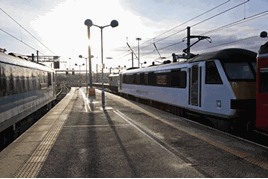It’s been nearly 30 years since East Anglia’s railways received any significant investment. That was back in 1987, when electrification of the line north of Ipswich to Norwich allowed Class 86s to serve the Norfolk city. They ran hourly, hauling stock dating from the 1970s.
Today, there are two trains an hour, formed of stock dating from the late 1970s/early 1980s. The locomotives date from the late 1980s. In RAIL 777’s Analysis, Philip Haigh likened the route to “what you would have found in BR days”… and he’s not wrong. A change is needed.
Railways have grown across the UK, and Anglia is no different. The region has also paid its way in premium payments back to Government that support the rest of the rail network. Yet the newest trains on the Great Eastern Main Line (GEML) date from 2003 - a fleet of 21 four-car Class 360 Desiros that run as far north as Stowmarket. Before that, Anglia Railways had introduced a fleet of eight Turbostars on Norwich-London trains, but they were removed from that line in 2010 - their limited capacity was by then inappropriate for such a busy route.
Class 90s (built 1987-1989) and Mk 3s (built 1977-1985) arrived from 2004. Remember that the Mk 3s were built originally for the electrification of the West Coast Main Line north of Crewe - if no new trains are ordered, they could yet enter a sixth decade of service if they have to continue to run beyond 2020. This is a region crying out for improvements and investment.
Politically there are no heavy hitters on the route, but there is a lot of support for investment. Chancellor of the Exchequer George Osborne and Secretary of State for Transport Patrick McLoughlin both back the ‘Norwich in 90’ campaign, which if introduced could mean trains running between London and Colchester in 40 minutes, London and Ipswich in 60 minutes, and London and Norwich in 90 minutes.
Support has grown for this campaign, and the region now heavily supports the plans. But are supporters looking too far ahead? What about the here and now?
Operator Abellio Greater Anglia (AGA) recorded the third worst satisfaction levels in the latest National Rail Passenger Survey (RAIL 778). Regular infrastructure failures blight the GEML, with the Twitter masses usually (and unfairly) blaming AGA. High-level discussions have been held between AGA and Network Rail management, but problems persist.
Aged infrastructure is a cause, and to this end NR is investing in new overhead line equipment (OLE), while the High Output Ballast Cleaner (HOBC) is being used as part of a multi million-pound scheme to improve the trackwork on the line. Even so, this remains more of a piecemeal project than overall improvements.
















Login to comment
Comments
No comments have been made yet.